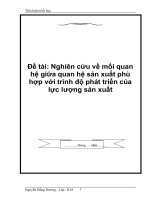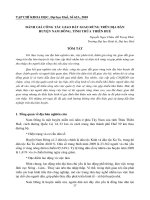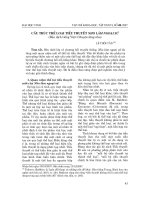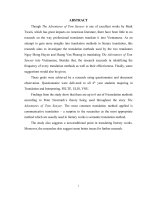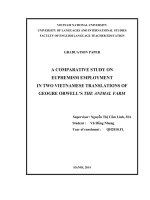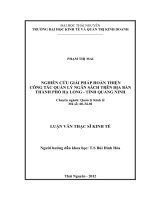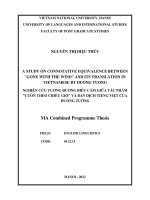Nghiên cứu tương đương biểu cảm giữa tác phẩm Cuốn theo chiều gió và bản dịch tiếng Việt của Dương Tương
Bạn đang xem bản rút gọn của tài liệu. Xem và tải ngay bản đầy đủ của tài liệu tại đây (179.41 KB, 15 trang )
1
Nghiên cứu tương đương biểu cảm giữa tác
phẩm "Cuốn theo chiều gió" và bản dịch tiếng
Việt của Dương Tương
Nguyễn Thị Diệu Thúy
Trường Đại học Ngoại ngữ
Luận văn ThS ngành: Ngôn ngữ Anh; Mã số: 60 22 15
Người hướng dẫn: Prof. Dr. Lê Hùng Tiến
Năm bảo vệ: 2012
Abstract: The researcher conducted a study to investigate the kinds of connotative
equivalence between the novel "Gone with the wind" and its translated version by
Duong Tuong. Different kinds of connotative equivalence have been identified.
Technical data from both the source text and target text was collected. Then the data
was examined carefully to assess the degree of connotative equivalence achieved. The
following five kinds of connotative equivalence are the most typical and well
achieved in the source text: connotations of speech level (elevated, normal, poetic,
and colloquial), connotations of socially determined usage (the language of the upper
class and the slaves), connotations of geographical origin (comparative structures),
connotations of register (military and religious), and connotations of evaluation
(pejorative, positive and ironic). All in all, it can be concluded that connotative
equivalence is achieved between the novel and the translation by Duong Tuong.
Keywords: Ngôn ngữ học; Tiếng Anh; Dịch thuật
Content
PART A: INTRODUCTION
I. Statement of the problem and rationale for the study
Over the past few decades, international exchange is processing vigorously in various
aspects, especially in culture. By using language to bridge the gap between different cultures,
inevitably, translation has contributed significantly to this process. Besides, literature has
been chosen as a rich source for translation. Literary works are not only written in different
languages but they also feature different cultures and civilizations. Accordingly, the literary
translation process is quite complex as it requires the translator to consider every aspect of
2
the material, or even beyond the material in order to produce a good translation. It poses a
great challenge for anyone who attempts to assess the quality of translated literary works.
According to Chesterman (1989) “Equivalence is obviously a central concept in
translation theory”. “The notion of equivalence held sway as a key issue in translation
throughout the 1970s and beyond.” (Munday, 2008, p. 49). Various works on translation
theories have been carried out just to show how vital equivalence is in translation. Great
importance has been attached to equivalence since this is a controversial issue and it is likely
to cause debates in the coming time. However, despite its significance, little investigation has
been carried out in the field of translation evaluation, particularly evaluation of equivalence
between English and Vietnamese literary works.
All the above made the researcher decide to carry out the study on equivalence in
literary translation. Specifically, the study investigates connotation equivalence achieved in
the translation of “Gone with the wind” – one of the most famous novels of the 20
th
century.
This novel has been chosen as the source language text due to its distinctive features,
aesthetic values and popularity worldwide. The novel was first translated into Vietnamese
more than 20 years ago. Among several versions of the translation, the one translated by
Duong Tuong is most praised by readers. With the aim of investigating one of Duong
Tuong's best translated works, the researcher chose his translation as the target text.
II. Research aims and research questions
The study firstly aims at providing a theoretical background on some issues relevant
to the topic of the study, which are translation, literary translation, equivalence in translation
and strategies to achieve equivalence.Secondly, the study is to investigate the types of
connotative equivalence achieved between the novel and its translated version. Thirdly, the
study is also aimed at finding out what strategies adopted by the translator in order to achieve
that equivalence.
Addressing the above issues is hoped to help English learners, especially those
specialize in translation enhance their awareness of various expressive means employed in a
particular literary text and decide the most appropriate strategies to deal with different
translation situations.
The study is also expected to be a good reference of criteria to any Vietnamese
readers who love romantic novel, and are fans “Gone with the wind” for a good translation.
These aims can be formulated into the following research questions.
3
1. What types of connotative equivalence achieved between the novel "Gone with the
wind" and its translation by Duong Tuong?
2. What strategies adopted by the translator to achieve such types of connotative
equivalence?
III. Scope of the study
Firstly, the theoretical background of the study only focuses on some fundamental
issues in translation theory which are of vital importance to the issue examined, which are
translation, equivalence, methods, and procedures.
Secondly, the research focuses on one kind of equivalence, which is connotative equivalence.
Then only the most outstanding types of connotative equivalence are examined
IV. Methods of the study
1. Data collection
The study is designed in accordance with the theory proposed by Koller (1979), that
is characterizes the connotative dimensions of a source language (with the support of stylistic
studies) to analyse their features and structural elements, and then relate these to the
connotative dimenstions of a given target language. In the first stage, the study explores the
source language text to find out the different dimensions of connotations. The features and
structural elements of each connotative dimension are defined. Data are collected in both
English and Vietnamese to illustrate these dimensions. Even though the novel is almost six
hundred pages long, the researcher tries to collect comprehensive data by investigating
almost every chapter. Subsequently, the examples are grouped according to the stated
catergory for the sake of comparison and assessment.
2. Data analysis
In the second stage of the study, an assessment of the features in the target language text
is carried out with the criteria established in the first stage. The translation and the data are
considered from various viewpoints. The study is based on technical data of semantic
densities, occurrence probabilities and repetition rates of both the source language and target
language text to evaluate the degree of connotative equivalence achieved. As stated by Koller
(1979), equivalence is defined in terms of the frame and conditions that the target text must
fulfill if there exists equivalence between a given source text and a given target text. The
conditions can be content, style, function, etc. Therefore, the requirement of equivalence has
4
the following form: quality (qualities) X in the source language text must be preserved,
meaning the source language content, form, style, function, etc must be preserved or at least
the translation must seek to preserve them as far as possible (Koller, 1979). Besides, the
connotations are transmitted by means of the word choice. Thus, the word choices that can
affect the content, form, style or function of translation are investigated carefully. After that,
conclusions on types of connotative equivalence achieved are drawn. Furthermore, based on
the translation of Duong Tuong, the researcher also figures out the strategies employed to
achieve connotative equivalence. The strategies are categorized according to Newmark's
theory about translation methods and translation procedures.
PART B - DEVELOPMENT
CHAPTER 1 – LITERATURE REVIEW
1.1. Definitions of translation
Translation, as one of the most ancient activity of human beings, has intrigued numerous
researchers all over the world. They all attempt to define translation for the sake of research,
and their definitions share one common thing: the relationship between the source text and
the target text.
In the “Dictionary of Translation Studies”, Shuttleworth and Cowie acknowledge that
translation is an “incredibly broad notion which can be understood in many different ways”.
And this idea is proved by numerous definitions proposed by different researchers around the
world.
Nida and Taber (1982, p.12) claim that “Translation consists in reproducing in the
receptor language the closest natural equivalent of the source language message, first in
terms of meaning and secondly in terms of style”.
Catford (1965, p.20) defines translation as “the replacement of textual material in one
language (Source language) by equivalent textual material in another language (target
language)." This idea is shared by Hartmann and Stock (1972, p713) with their definition
“Translation is the replacement of a representation of a text in one language by a
representation of another equivalent text in a second language.”
Interestingly, Dubois (as cited in Bell, 1991, p.5) expresses the same notion “Translation
is the expression in another language (or target language) of what has been expressed in
another (source language), preserving semantic and stylistic in equivalences”.
5
1.2. Translation equivalence
1.2.1. Roman Jakobson and the concept of equivalence in difference.
Roman Jakobson claims “equivalence in difference is the cardinal problem of
language and the pivotal concern of linguistics” and introduced the notion of "equivalence in
difference". In his point of view, “there is ordinarily no full equivalence between code-units”
because “the translator recodes and transmits the message from another source. Thus
translation involves two equivalent messages in two different codes” (p.139). The problem of
meaning and equivalence lies in the structure and terminology of languages rather than the
inability of one language to render a message into another language.
1.2.2.Nida and Taber's Formal equivalence and dynamic equivalence
Nida categorizes equivalence into two fundamental types: formal equivalence and
dynamic equivalence. Formal equivalence focuses on the source text structure, whose role is
to determine the accuracy of the translation. Formal equivalence is used to get closer to the
language and customs of the source culture. The second type of equivalence proposed by
Nida is dynamic equivalence (or functional equivalence), in which “the relationship between
receptor and message should be substantially the same as that which existed between the
original receptors and the message” (Nida, 1964, p.159). Nida claims that previously,
translating only focused on the form of the message, meaning that translator only searched
for “formal equivalence” - Nida’s term. However, the new focus in the response of the
receptor or the reader, meaning that translator should look for what Nida calls “dynamic
equivalence”. “Dynamic equivalence” was discussed in Nida’s work in 1964, and was further
discussed in this book. The impacts of dynamic equivalence on the translation of
grammatical meaning, referential meaning and connotative meaning are studied.
Furthermore, the effect on translation of idioms, discourse structure, language variety, types
of discourse and style are also the topic of discussion.
1.2.3. Catford and translation shifts
Catford approaches the issue of textual equivalence through translation “shifts”,
meaning "departures from formal correspondence in the process of going from the source
language to the target language" (p.73). He categorizes shifts into four types, which are
structure shifts, class shifts, unit shifts and intra – system shifts. In his viewpoint, two
utterances can be equivalent but they do not have the same meaning as different languages
will verbalize different situational features. Equivalence can be achieved when the source
6
and target words are “interchangeable in a given situation” and this happens when “a source
language and a target language text or item are relatable (at least some of) the same features
of substance” (Catford, 1965, 50).
1.2.4. Kade and quantitative equivalence
Otto Kade (as quoted in Pym, 2010) develops a theory that categorizes equivalence at word
or phrase- level into four modes: “One – to- one”, “One- to – several” or “several-to-one”,
“One- to- part”, “One – to- none”. Kade’s quantitative approach has been criticized because
it is restricted to the word level and it assumes that the language system can be equated with
concrete realization in text (Snell – Hornby, 1988, 20).
1.2.5.Baker's approach to translation equivalence
Baker (1992) explores the notion of equivalence at different levels, in relation to the
translation process, including all different aspects of translation putting together the linguistic
and the communicative approach. The first level is equivalence at word- level and above
word- level. The second level is grammatical equivalence, referring to the diversity of
grammatical categories across languages. The third level is textual equivalence, which refers
to the equivalence between a source language text and a target language text in terms of
information and cohesion. The final level is pragmatic equivalence, referring to implicatures
and strategies of avoidance during the translation process.
1.2.6.Koller's theory of equivalence
According to Koller (1979), equivalence refers to the relationship between source
language text and target language text, rather than between two languages. When mentioning
the concept of equivalence, it is necessary to define the frame and conditions. Then, if the
target text fulfill certain conditions as defined, there exists equivalence between a given
source text and a given target text. Koller claims that the relevant conditions refer to such
aspects as content, style, function, etc. thus, the requirement of equivalence has the following
form: quality (qualities) X in the source language text must be preserved, or at least the
translation must seek to preserve them as far as possible.
After defining the conditions of equivalence, Koller categorizes equivalence into five
types.: denotative, connotative, pragmatic, text – normative, and formal equivalence.
Especially, connotative equivalence is further categorized into nine subcategories, that are
7
connotations of speech level (connotative values such as elevated, poetic, normal, colloquial,
slang, vulgar), connotations of socially determined usage (student language, military usage,
working –class language, educated class, etc), connotations of geographical relation or origin
(non-regional, American English, dialects, etc, connotations of medium (spoken language,
written language), Connotations of stylistic effect (archaic, pompous, artificial, fashionable,
euphemistic, plain, descriptive, etc), Connotations of frequency (common, uncommon),
Connotations of register (normal usage, technical, medical), connotations of evaluation
(positively evaluative, pejorative, ironic, etc), connotations of emotion (emotive, neutral)
1.3. Translation of literature
Stockwell (2002, a), Venuti (1996), Pilkington (2000), Berman (1985/2000) all mention
the typical features of literary translation, and collected by Baker, including: they have a
written – based form, they enjoy canonicity (high social prestige), they fulfill and
effective/aesthetic rather than transactional or informational function, they aim to evoke
emotions and/or entertain rather than influence or inform; they have no real- world truth-
value (meaning they are judged as fictional, whether fact-based or not); they feature words,
images with ambiguous and/or indeterminable meanings; they are characterized by “poetic”
language use. Conventional “core literary” genres are drama, poetry, and fictional prose.
However, a text only display some of the features listed above.
According to Baker, the focus of literary translation studies is source- target text relations.
Specifically, equivalence and communicative purpose are the main focus of attention.
Holmes (1988, 53) & Jones (1989) claim that the pivotal issue regarding equivalence is the
translator’s ability to convey exactly the stylistic features of literary texts. In case that
situation is impossible, what should be given priority? Another school of thought is that the
translator should attach importance to communicative effectiveness instead of equivalence.
In terms of communicative purpose, the question posed here is to what extent should the
translator be loyal to the original text?
1.4. Translation methods
There are eight methods proposed by Newmark (1988): word – for – word translation,
literal translation, faithful translation, semantic translation, communicative translation,
idiomatic translation, free translation and adaptation.
1.5. Translation procedures
8
The following procedures are proposed by Newmark (1988) to translate sentences and
smaller units of sentences: naturalization, transference, shifts, cultural equivalent, functional
equivalent, descriptive equivalent, synonym, through translation, modulation, componential
analysis, paraphrase, couplets.
1.6. The writer Margaret Mitchell and the novel "Gone with the wind"
1.7. The translator Duong Tuong and the translation "Cuon theo chieu gio"
CHAPTER 2 – CONNOTATIVE EQUIVALENCE
2.1. Connotations of socially determined usage
Firsly, in terms of connotations of socially determined usage, two contrast
kinds have been achieved: the language of the upper class in the society, and the language of
the slaves. The language of the upper class is is highly formal and Duong Tuong also used
literal translation, with focus on formal expressions to achieve this connotation successfully.
The upper class in the novel is also the slave owners, therefore, apart from formal language,
short sentences and commands with simple words are also used when talking to the slaves.
Duong Tuong takes advantage of the address system in Vietnamese, which is different from
that of English but of great help to show the language style. The novel also features the
language of the slaves, which are grammatically incorrect and misspelt. Duong Tuong takes
this seriously and tries to convey the intention of the writer by choosing word choices that
can also illustrate the slaves' lack of education. Even though Duong Tuong seems to lessen
the significance of grammatical and spelling mistakes made by slaves so that the target
readers might understand the subject matter much more easily, the translation still achieves
this connotation thanks to the appropriate word choices of the translator.
2.2. Connotations of speech level
As regards connotations of speech level, four types of connotations are achieved,
which are elevated, poetic, normal and colloquial. Elevate speech is dedicated to the South's
army, the heroes in the heart of all Southerners. The greatness of the Cause, and the Southern
people are emphasized in the novel by elevated style. Literal translation with semantic
9
orientation is employed by Duong Tuong to reproduce the epic paragraphs so that the
intention of the writer is fully conveyed to the target readers. For poetic language, which is
clearly illustrated in the songs and poems in the novel, Duong Tuong also successfully
achieves connotative equivalence by adopting adaptation translation method to recreate the
poems and songs in the target language. Vietnamese readers can sense the spirit of poetic
language in his translation. The last type of speech level is colloquial, and the translation of
interjections and exclamations are investigated carefully. The result is that in most cases,
interjections and exclamations in English are translated by literal translation - appropriate
interjections and exclamations in Vietnamese, producing the equivalent effect. However,
Duong Tuong does have some bizarre translation, making it hard for the target readers to
understand. But in general, connotative equivalence is still achieved.
2.3. Connotations of geographical origin
The third type of connotations is connotation of geographical origin, with the focus
on comparative structures because the majority of them are culture – and language – specific.
To treat the structures in such a way that the target readers can obtain an understading of the
source culture, literal translation is employed by Duong Tuong. In some cases, Duong Tuong
uses cultural equivalent to make the translation sound natural to the target readers.
Obviously, in such cases, connotation of geographical origin is not achieved. However, such
cases only accounted for a small proportion. All in all, connotation of geographical origin is
achieved.
2.4. Connotations of register
Military, religious and normal usages are the three types of connotations of register
which have been examined. For military and religious register, appropriate word choices
bearing military and religious connotations successfully conveys the "spirit" of the two kinds
of register. As regards noun phrases in normal usage, literal translation plays an important
role. Besides, shifts are also used quite frequently to ensure the appropriatness of
grammatical structures in the target language.
2.5. Connotations of evaluation
Finally, three kinds of connotations of evaluation, which are pejorative, positive and
ironic, are examined. Literal translation is still the main procedure. Besides, to achieve
10
pejorative connotation, Duong Tuong focuses on the address system, and the use of words of
negative connotations. Similarly, to achieve connotation of positive evaluation, words of
positive connotation are used. As for ironic evaluation, expressive words which can convey
fully the intention made by the writer are intensively used. In general, connotation of
evaluation is another success of Duong Tuong.
All in all, what can be inferred from the analysis is that these above five dimensions of
connotative equivalence is achieved between the novel and and its translation
11
CHAPTER 3 – FINDINGS AND RECOMMENDATIONS
3.1. Summary of findings
The study is designed in accordance with the theory proposed by Koller (1979), that is
the connotative dimensions of a source language (with the support of stylistic studies) to analyse
their features and structural elements, and then relate these to the connotative dimenstions of a
given target language. In the first stage, the study explores the source language text to find out
the different dimensions of connotation. the following five types of connotations have been
identified by the researcher, which are: connotations of socially determined usage (the language
of upper class and slaves), connotations of speech level (elevated, poetic, normal, colloquial),
connotations of geographical origin (comparative structures), connotations of register (military
and religious), connotations of evaluation (pejorative, positive, ironic).
In the second stage of the study, an assessment of the types of connotative equivalence
achieved is carried out. With careful investigation of different connotative dimenstions, it can be
concluded that literal translation is the most common procedure used by Duong Tuong. Besides,
shifts, cultural equivalent, adaptation are also be used. It is the word choices of the translator that
play a vital role in reproducing the similar message to the target readers like those obtained by
the readers of the source text. All in all, Duong Tuong is successful in achieving the five
dimentions of connotative equivalence by his great translation skills.
3.2. Recommendations
3.2.1. To achieve connotations of socially determined usage
Socially determined usage refers to the language use of a particular class or group in the
society. The factor characterizes this usage is word choices, the way each class or group word
their expressions. Thus, in order to achieve this kind of connotations, the translator has to attach
great importance to his/her word choices in the translation. Specifically, the prominent feature in
the language of a particular class must be preserved and conveyed to the translation. For
instance, the upper class's language emphasizes the use of formal expression, and complicated
structures. On the contrary, working class's language is muc simpler with plain expressions and
grammatical structures. The translation must translate with such features in the target language
so that the target readers can realize the distinctions in language use of different social classes.
3.2.2.To achieve connotations of speech level
This kind of connotation focuses on the connotative values of the text, such as elevated,
poetic, normal, colloquial, slang, or vulgar. The connotation is transmitted by word choices and
12
writing styles. In order to achieve connotation of elevated, for instance, formal and solemn words
should be used. Sometimes, the translation should sound polished and elegant. For connotation
of poetic, the utmost thing is maintaining the format of the source text, which is usually in the
form of songs or poems. In this case, the form should be prioritized, sometimes at the expense of
meaning. This kind of equivalence is quite hard to achieve since the translator must act as a
poem or a songwriter. Colloquial, slang or vulgar are mainly used in conversations, therefore,
spoken expressions should be employed in the target language to make the translation sound
casual.
3.2.3.To achieve connotations of geographical origin
This kind of connotation is quite popular due to the fact that there always remain cultural
and language differences between any two languages. The translator often faces a dilemma here.
If he/she wants to make the translation sound natural to the targer readers, cultural equivalent
should be employed. However, the apply of this procedure deprives expressions of their origin,
resulting in the target readers' lack of understanding about the source culture. Accordingly, if the
translator wishes to achieve geographical origin, literal translation should be used to keep the
foreignness. Nevertheless, in such cases, the translation must be treated with great care to avoid
bizarre translation.
3.2.4.To achieve connotations of register
Register connotations mainly depend on the situation in which language is used. Register
may vary greatly, from medical to political or military context. In order to achieve this kind of
connotation, the translator must be able to identify the context of the message and choose the
appropriate language style to render the message. In such case, context plays a vital role as the
same word may have different meanings in different contexts.
3.2.5. To achieve connotations of evaluation
Pejorative, positive or ironic are some examples of evaluation, which are expressed by
the use of certain expressions, especially emotive ones. Hence, the expressions must be analyzed
carefully by the translator to figure out the intention transmitted by the writer, for example, to
distinguish between a compliment and an irony. Then the translator can decide which procedure
should be used, which orientation should be followed, the choice of such depends on the
intention of the translator, meaning how close the translator wants the target text to the source
text.
13
PART C – CONCLUSION
I. Contributions of the study
Overall, the research on assessment of connotative equivalence achieved between the novel
"Gone with the wind" and its translated version could be considerably helpful for students as
well as researchers of translation studies in general and translation quality assessment in
particular.
As for students of translation, this research provides them with background knowledge
about translation, translation equivalence, translation methods and translation procedures.
Besides, this research is also hoped to have them gained some insight into connotative
equivalence and how to achieve it by using translation procedures, especially in the case of
"Gone with the wind" and the translation by Duong Tuong.
Researchers who develop an interest in the same research area can refer to this study for
reliable and useful information for their future related work.
II. Limitations of the study
First, the study only investigates five dimentions of connotative equivalence out of nine
dimensions. The conclusion drawn would be much more comprehensive if all dimension of
connotative equivalence were examined. Second, the data collected was not diversified and the
analysis of data was not deep enough to evaluate the achievement of connotative equivalence in
detail.
Despite the aforementioned shortcomings, the researcher’s serious work and justified
data collection and research methodology had ensured the validity and reliability of the results.
Nevertheless, it is noteworthy that these above shortcomings should be taken into account when
further related studies are conducted in the future.
III. Suggestions for further studies
If there were more time and resources, the researcher would like to investigate the
following issues. Apart from the dimensions of connotative equivalence mentioned and
examined in the thesis, there are other kinds of connotations, such as connotations of medium,
connotations of stylistic effect, connotation of frequency and connotations of emotion. Further
studies may investigate those connotations to achieve a much more solid conclusion about the
14
connotative equivalence between the source language text and the target language text. Bedies,
denotative equivalence and pragmatic equivalence are also potential research area. It is advisable
to assess these types of equivalence to make the study more comprehensive and valuable.
References
1. Baker, M. (1992). In Other Words. USA & Canada: Routledge.
2. Baker, M., & Saldanha, G (Eds). (2009). Routledge Encyclopedia of Translation Studies (2
nd
ed). USA & Canada: Routledge.
3. Bassnett, S. (2002). Translation Studies (3
rd
ed). USA & Canada: Routledge.
4. Catford, J, C. (1965). A Linguistic Theory of Translation: an Essay on Applied
Linguistics. London: Oxford University Press.
5. Chesterman, A. (1989). Readings in Translation Theory. Findland: Loimaan Kirjapaino Oy.
6. Fast, P., & Osadnik, W.M (Eds). (1998). Studies in comparative literature and translation
(Vol 1). Edmonton: University of Alberta
7. Hatim, B., & Munday, J. (2004). Translation An Advanced Resource Book. USA, Canada:
Routledge
8. Hartman, R.R.K., & Stork, R.C. (1972). Dictionary of Language and Linguistic. In Bell, R.T,
Translation and Translating: Theory and Practice. London & New York: Longman
9. Jakobson, R. (2004). On Linguistic aspect of translation. In Venuti, L (Ed), The Translation
Studies Reader (pp. 138 – 143). London: Routledge
10. Koller, W. (1979). Equivalence in translation theory. In Chesterman, A (Ed), Readings in
Translation Theory (pp. 186 – 191). Findland: Loimaan Kirjapaino Oy.
11. Landers, C.E. (2001). Literary Translation. Great Britain: Cromwell Press Ltd.
12. Munday, J. (2008). Introducing Translation Studies (2
nd
ed). USA, Canada: Routledge.
13. Newmark, P. (1988). Approaches to Translation. UK: Prentice Hall International Ltd.
14. Newmark, P. (1988). A Textbook of Translation. UK: Prentice Hall International Ltd.
15. Nida, E. A. (1964). Toward a Science of Translating. Leiden: E.J. Brill
16. Nida, E. A., & Taber, C. R. (1982). The Theory and Practice of Translation (2
nd
ed).
Leiden: E.J. Brill
17. Pym, A. (2010). Exploring Translation Theories. USA & Canada: Routledge.
18. Snell – Hornby, M. (1988). Translation Studies: An Integrated Approach. Amsterdam and
Philadelphia: J. Benjamins Pub. Co.
15
19. Shuttleworth, M. , & Cowie, M. (1997). Dictionary of Translation Studies. Manchester: St
Jerome
20. Fawcett, P. (1997). Translation and Language Linguistic Theories Explained. Manchester:
St Jerome.
